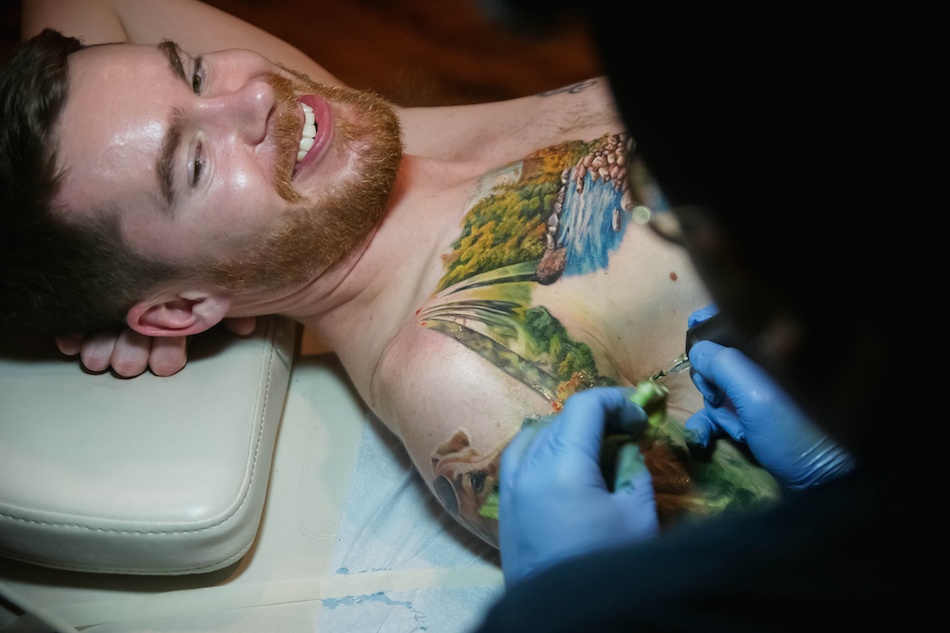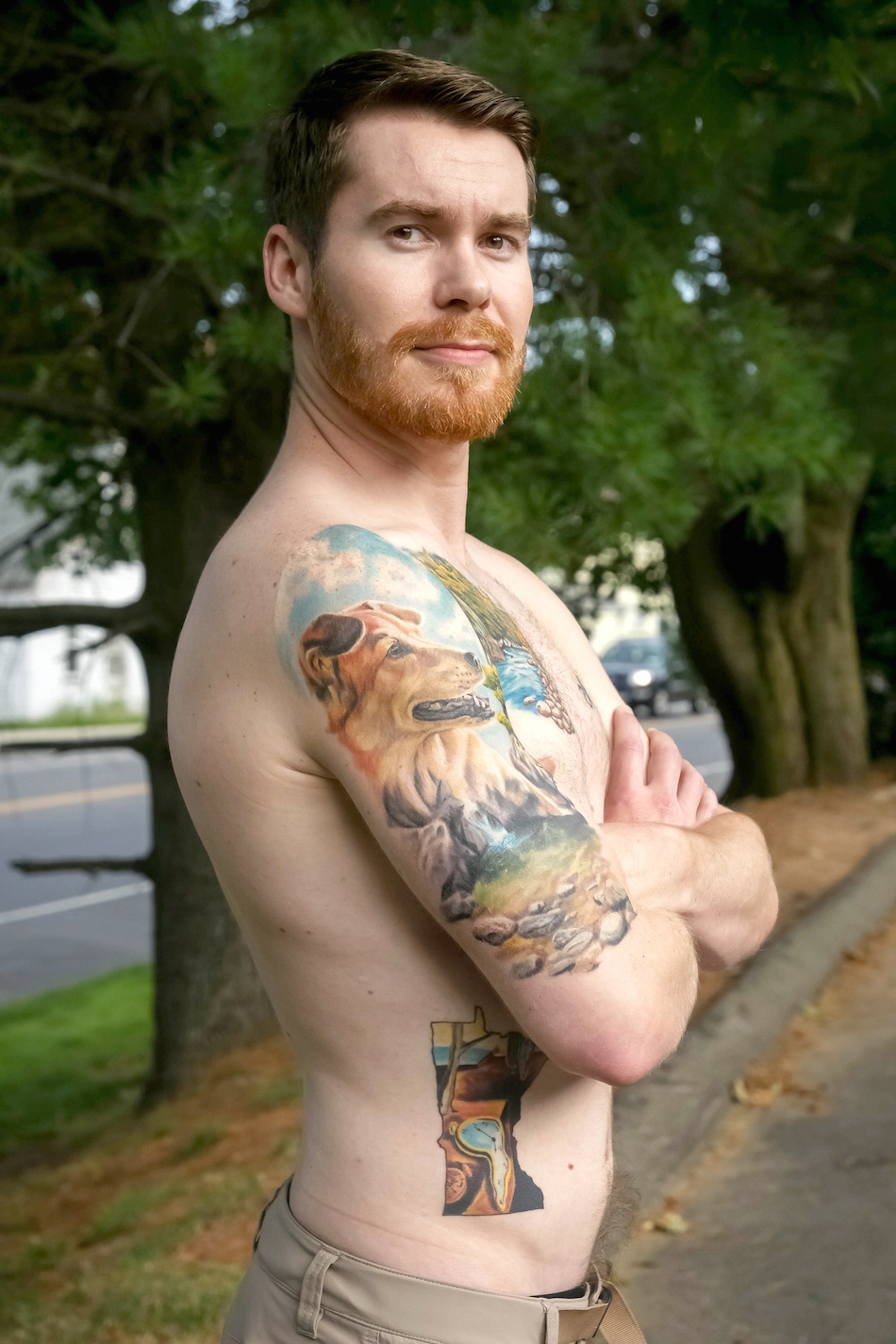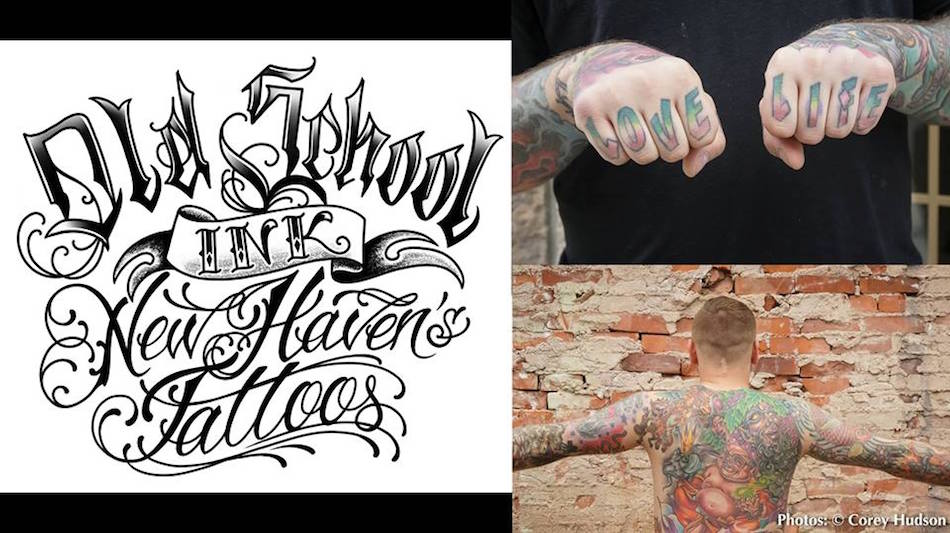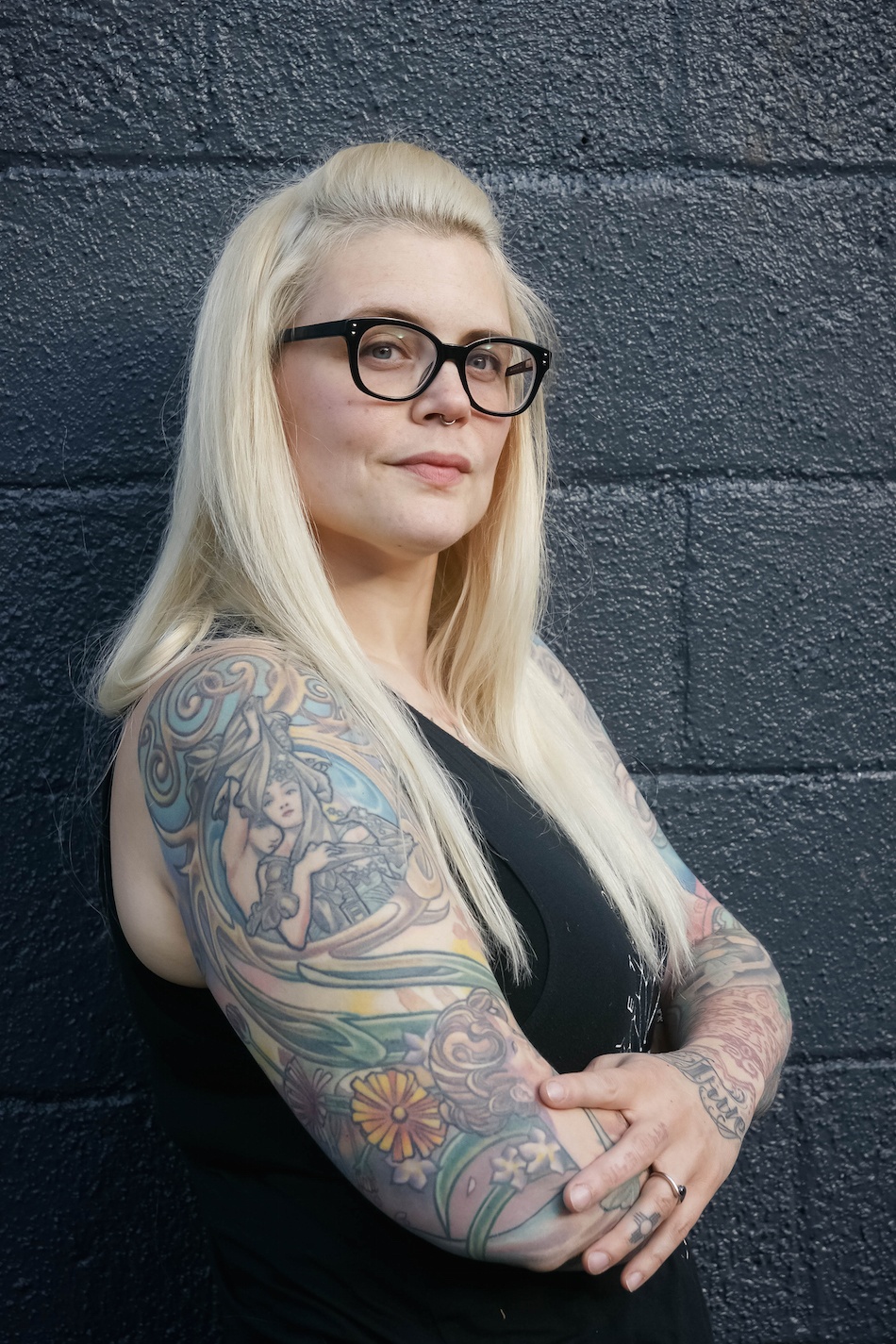
Jake Ness gets tattooed. Corey Hudson Photos.
A dog looks expectantly across a clear blue sky. In the picture, she grins widely. Beneath her, water tumbles from a rocky hillside and a perfect green lawn surrounds the pools into which the water flows.
This scene can’t be found in a photograph or hanging on a wall. Instead, this intricate and beautiful picture exists on the right arm of a young bearded man. The tattoo is photographically rendered and the content unmistakably personal. It is a piece of art.
The New Haven Museum’s latest exhibition will explore the complicated and beautiful world of tattooing. The exhibit, entitled Old School Ink: New Haven’s Tattoo opens September 23 and runs through mid-March 2018. Interviews with tattoo recipients and artists alike will be part of the exhibit, alongside tattoo photos and new art created specifically for the show from research into the Museum’s collections. Local tattoo artists have influenced the trade worldwide, and the exhibit will be a showcase for those efforts.

“We are trying to do much more than just say something super definitive about the past. We will be inviting the contemporary tattoo community to tell their stories and be represented,” said curator Elinor Slomba. “This is our story, [which is also] part of New Haven’s story.”
Slomba’s work over the years has been focused at the intersection of arts, culture, and economic development. The history of tattooing falls directly into those crosshairs. The modern tattoo artist is a creative entrepreneur working in a field that undergoes tremendous governmental regulation. The art form itself has evolved as cultural norms have changed. What was once the province of the outsider is now ubiquitous.
“Tattooing is a kind of art collecting that is more accessible to everyone than maybe some kinds of art. It’s a collaboration between the client and the artist,” Slomba said.
The history of physical marking in New Haven goes back to its founding in the 17th century. There are records of criminals in the nascent colony being branded for their crimes. The first tattoo artist emerges into the historical record in 1887. Henry Silver had a tattoo shop and advertised in the local newspaper alongside other shops of the day.
“Even his name is evocative,” said Slomba, who is still looking into his biographical data. Nineteenth century ornamentation was a simpler affair—smaller marks, crosses or initials tended to be the standard fare done by hand. Tattooing was often connected to maritime pursuits.
New Haven County can also claim an important innovation in the history of the form. The patent for the first electric tattooing machine was secured in 1881. Patent holder Samuel O’Reilly—also known as “the professor”—began his career working in the brass industry. After a couple of stints in the state penitentiary in Wethersfield for burglary and then a hitch in the Navy, O’Reilly took up tattooing as his trade.

Courtesy New Haven Museum.
He had seen a demonstration of Thomas Edison’s electric pen and got excited about the possibilities it could offer tattooing as a form. In fact, use of the tattooing machine became a sales point in and of itself—you were marked by electricity. The history of the industry is filled with unique characters, and the exhibit will feature some of their stories.
“We are still separating folklore from fact as much as we can,” she said. “Many tattoo artists had stories about them as part of their marketing. There was a certain hyperbole. Some of the people who were famous for getting tattooed earned a living letting people see their tattoos.”
Photojournalist Corey Hudson interviewed artists and connoisseurs, photographing their work in connection with the exhibit. Hudson will be present on opening day photographing visitors’ tattoos. Working on the Old School Ink project, he found a deeply emotional and complicated culture, one that makes him very seriously consider having work done himself.

Tracey Rose of Lucky Soul Tattoo.
“Tattoos, for a lot of people, represent a place, a threshold, a passage in their lives,” Hudson said. “For me, it feels like I’ve been wrestling with the decision (to get a tattoo) for about 20 years, but I’ve never been certain about what was important enough to wear on your body for your whole life. That’s a decision many people go through.”
Initially, entrance to tattoo culture could be found through the military or the music and biker scenes.
“It was people who didn’t feel accepted in society somehow. It gave them something that was their own … you had to be initiated into the process,” Hudson said. “It was a sign of rebellion towards something.”
Tattooing, while distinctly considered a trade by many people, also became a place where artists could express themselves while earning a living. Artists had the opportunity to work in three dimensions on a unique canvas, fostering new creativity and energy. The days of simply selecting from a series of pre-made tattoo designs, called flash sheets, is over. The collaboration between client and artists creates work that both reflects the artist’s own aesthetic and the personal expression of the person wearing the art. The results are stunning and intricate, ranging from literal scenes such as the one described at the beginning, to complex designs replete with meaning.
“If I think about the experience of tattooing and what it is to me, and kind of like what I’ve been describing a tattooer is or should be, it’s kind of like a therapist and a midwife, or doula or something. You’re helping people through this experience that’s painful—sometimes it’s not, but most of the time it is—and sometimes it’s really emotionally painful. You know, people leave feeling like they’ve just … it’s like cathartic,” said Tracey Rose, a tattoo artist at Lucky Soul Tattoo who spoke with Hudson for the exhibit.
For the many people who have embraced tattoo culture, it is an opportunity for their outside to connect to what they feel inside. Finding the right tattoo, one that expresses what is going on in their hearts and in their minds, is a way of becoming a more perfect self.
“We think of tattoos as permanent, but our bodies aren’t permanent. There is some poignancy there,” Slomba said.
The opening event on Sept. 23 will be part of the Smithsonian Museum Day Live! events across the country. Free tickets for the New Haven Museum (and many others) are available here.